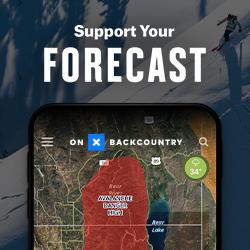In conditions like these it's hard to know which avalanche problem to pick because they're all mixed up together. But according to our flowchart on the wall, we're supposed to call any slab on top of a persistent weak layer a "persistent slab" whether it's a wind slab or storm snow. So we have storm snow and wind slabs on top of a persistent weak layer--whatever you want to call it.
It's hard to tell whether the slabs are breaking on top of the pre-existing faceted layer (with surface hoar mixed in) or on the low density snow just on top of the faceted layer. Not that it makes any difference except to avalanche geeks, but then again, I don't even care. Stiff, dense, warm slabs are overloading weak snow underneath them. That's all anyone needs to know. I notice that the snow started yesterday without hardly a breath of wind on the high peaks, so much of the low density new snow is probably preserved. Just under that is weak faceted snow, continues all to way to the ground in areas with less than about 50 cm and has a supportable layer in places deeper than about 50 cm.



